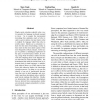Free Online Productivity Tools
i2Speak
i2Symbol
i2OCR
iTex2Img
iWeb2Print
iWeb2Shot
i2Type
iPdf2Split
iPdf2Merge
i2Bopomofo
i2Arabic
i2Style
i2Image
i2PDF
iLatex2Rtf
Sci2ools
ACL
2008
2008
Multilingual Harvesting of Cross-Cultural Stereotypes
People rarely articulate explicitly what a native speaker of a language is already assumed to know. So to acquire the stereotypical knowledge that underpins much of what is said in a given culture, one must look to what is implied by language rather than what is overtly stated. Similes are a convenient vehicle for this kind of knowledge, insofar as they mark out the most salient aspects of the most frequently evoked concepts. In this paper we perform a multilingual exploration of the space of common-place similes, by mining a large body of Chinese similes from the web and comparing these to the English similes harvested by Veale and Hao (2007). We demonstrate that while the simile-frame is inherently leaky in both languages, a multilingual analysis allows us to filter much of the noise that otherwise hinders the knowledge extraction process. In doing so, we can also identify a core set of stereotypical descriptions that exist in both languages and accurately map these descriptions ont...
| Added | 29 Oct 2010 |
| Updated | 29 Oct 2010 |
| Type | Conference |
| Year | 2008 |
| Where | ACL |
| Authors | Tony Veale, Yanfen Hao, Guofu Li |
Comments (0)

